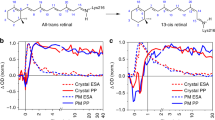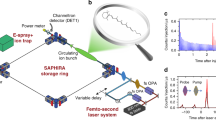Abstract
A femtosecond (fs) broad-band absorption apparatus was used to measure the early photoisomerization process of bacteriorhodopsin’s (BR) photocycle to reveal the character of the important intermediate of J625 and to obtain a deeper understanding of the role of photoisomerization in BR photocycle. Two time constants of 0.5 ps (95%) and 2.0 ps (5%) were brought out by global fitting on thirty curves in the near-infrared region. We suggest that the first time constant results from the decay of I460 intermediate, and the longer component might be associated with BR isomer. The global analysis over 450, 540, 630, 710 and 870 nm traces identified two time constants, ∼0.5 and ∼3 ps. The slower component can be extracted from the processes of both J625→BR568 (540 nm) and J625→K590 (630 nm), suggesting J-intermediate takes a partial cis configuration. The obvious negative feature in early delay time of 700–780 nm regions was attributed to the radiative transition (stimulated emission) from the Franck-Condon active configuration along the isomerization potential surface of all-trans-retinal.
Similar content being viewed by others
References
Oesterhelt D, Stoeckenius W. Rhodopsin-like protein from the purple membrane of Halobacterium halobium. Nature New Biol, 1971, 233(39): 149–152
Racker E, Stoeckenius W. Reconstitution of purple membrane vesicles catalyzing light-driven proton uptake and adenosine triphosphate formation. J Biol Chem, 1974, 249(2): 662–663
Lewis A, Spoonhower J, Bogomolni R A, et al. Tunable laser resonance Raman spectroscopy of bacteriorhodopsin. Proc Natl Acad Sci USA, 1974, 71(11): 4462–4466
Katre N V, Wolber P K, Stoeckenius W, et al. Attachment site(s) of retinal in bacteriorhodopsin. Proc Natl Acad Sci USA, 1981, 78(7): 4068–4072
Pettei M J, Yudd A P, Nakanishi K, et al. Identification of retinal isomers isolated from bacteriorphodopsin. Biochemistry, 1977, 16(9): 1955–1959
Braiman M, Mathies R A, Resonance Raman spectra of bacteriorhodopsin’s primary photoproduct: Evidence for a distorted 13-cis-retinal chromophore. Proc Natl Acad Sci USA, 1982, 79(2): 403–407
Dobler J, Zinth W, Kaiser W, Oesterhelt D. Excited-State reaction dynamics of bacteriorhodopsin studied by femtosecond spectroscopy. Chem Phys Lett, 1988, 144(2): 215–220
Mathies R A, Cruz C H B, Pollard W T, et al. Direct observation of the femtosecond excited-state cis-trans isomerization in bacteriorhodopsin. Science, 1988, 240(4853): 777–779
Hasson K C, Gai F, Anfinrud P A. The photoisomerization of retinal in bacteriorhodopsin: experimental evidence for a three-state model. Proc Natl Acad Sci USA, 1996, 93(26): 15124–15129
Gai F, Hasson K C, McDonald J C, et al. Chemical dynamics in proteins: the photoisomerization of retinal in bacteriorhodopsin. Science, 1998, 279(5358): 1886–1891
Schulten K, Humphrey W, Lugunov I, et al. Molecular dynamics studies of bacteriorhodopsin’s photocycle. Isr J Chem, 1995, 35: 447–464
Du M, Fleming G. R. Femtosecond time-resolved fluorescence spectroscopy of bacteriorhodopsin-direct observation of excited-state dynamics in the primary step of the proton pump cycle. Biophys Chem, 1993, 48(2): 101–111
Haran G, Wynne K, Xie A. H, et al. Excited state dynamics of bacteriorhodopsin revealed by transient stimulated emission spectra. Chem Phys Lett, 1996, 261(4–5): 389–395
Alfano R R, Govindjee W Y R, Becher B, et al. Picosecond kinetics of the fluorescence from the chromophore of the purple membrane protein of Halobacterium halobium. Biophys J, 1976, 16(5): 541–545
Shapiro S L, Campillo A J, Lewis A, et al. Picosecond and steady state, variable intensity and variable temperature emission spectroscopy of bacteriorhodopsin. Biophys J, 1978, 23(3): 383–393
Delaney J K, Brack T L, Atkinson G H, et al. Primary picosecond molecular events in the photoreaction of the BR5.12 artificial bacteriorhodopsin pigment. Proc Natl Acad Sci USA, 1995, 92(6): 2101–2105
Zhong Q, Ruhman S, Ottolenghi M, et al. Reexamining the primary lightinduced events in bacteriorhodopsin using a synthetic C13=C14-locked chromophore. J Am Chem Soc, 1996, 118(51): 12828–12829
Rousso I, Khachatryan E, Gat Y, et al. Microsecond atomic force sensing of protein conformational dynamics: Implications for the primary light-induced events in bacteriorhodopsin. Proc Natl Acad Sci USA, 1997, 94(5): 7937–7941
Garavelli M, Celani P, Bernardi F, et al. The C5H6NH2+ protonated shiffbase: An ab initio minimal model for retinal photoisomerization. J Am Chem Soc, 1997, 119(29): 6891–6901
Song L, El-Sayed M A. Primary step in bacteriorhodopsin photosynthesis: Bond stretch rather than angle twist of its retinal excited-state structure. J Am Chem Soc, 1998, 120(34): 8889–8890
González-Luque R, Garavelli M, Bernardi F, et al. Computational evidence in favor of a two-state, two-mode model of the retinal chromophore photoisomerization. Proc Natl Acad Sci USA, 2000, 97(17): 9379–9384
Atkinson G H, Ujj L, Zhou Y. Vibrational spectrum of the J-625 intermediate in the room temperature bacteriorhodopsin photocycle. J Phys Chem A, 2000, 104(18): 4130–4139
Ujj L, Zhou Y, Sheves M, et al. Vibrational spectrum of a picosecond intermediate in the artificial BR5.12 photoreaction: Picosecond time-resolved CARS of T5.12. J Am Chem Soc, 2000, 122(1): 96–106
Herbst J, Heyne K, Diller R. Femtosecond infrared spectroscopy of bacteriorhodopsin chromophore isomerization. Science, 2002, 297(5582): 822–825
Polland H J, Franz M A, Zinth W, et al. Early picosecond events in the photocycle of bacteriorhodopsin. Biophys J, 1986, 49(3): 651–662
Han R M, Wu Y S, Feng J, et al. Radical cation generation from singlet and triplet excited states of all-trans-lycopene in chloroform. Photochem Photobiol, 2004, 80(2): 326–333
Kobayashi T, Terauchi M, Kouyama T, et al. Femtosecond spectroscopy of acidified and neutral bacteriorhodospin. Proc SPIE-Int Soc Opt Eng, 1991, 1403: 407–416
Nuss M C, Zinth W, Kaiser W, et al. Femtosecond spectroscopy of the first events of the photochemical cycle in bacteriorhodopsin. Chem Phys Lett, 1985, 117(1): 1–7
Kryukov P G, Matveets Y A, Sharkov A V, et al. Lasers in photomedicine and photobiology. Springer Ser Opt Sci, 1980, 22: 200–206
Van den Berg R, Jang H C, Bitting D J, et al. Subpicosecond resonance Raman spectra of the early intermediates in the photocycle of bacteriorhodopsin. Biophys J, 1990, 58(1): 135–142
Haacke S, Schenkl S, Vinzani S, et al. Femto-and picosecond fluorescence studies of native bacteriorhodopsin and of a non-isomerizing analog. Biopolymers, 2002, 67(4–5): 306–309
Schmidt B, Sobotta C, Heinz B, et al. Excited-state dynamics of bacteriorhodopsin probed by broadband femtosecond fluorescence spectroscopy. Biochim Biophys Acta, 2005, 1706(1–2): 165–173
Koyama Y, Nakasu H, Mukai Y, et al. Isomerization of the retinylidene chromophore of bacteriorhodopsin in light adaption: Intrinsic isomerization of the chromophore and its control by the apo-protein. Photochem Photobiol, 1993, 57(3): 732–738
Tittor J, Oesterhelt D. The quantum yield of bacteriorhodopsin. FEBS Lett, 1990, 263(2): 269–273
Govindjee R, Balashov S P, Ebrey T G. Quantum efficiency of the photochemical cycle of bacteriorhodopsin. Biophys J, 1990, 58(3): 597–608
Rohr M, Gartner W, Schweitzer G, et al. Quantum yields of the photochromic equilibrium between bacteriorhodopsin and its bathointermediate K: Femto-and nanosecond optoacoustic spectroscopy. J Phys Chem, 1992, 96(14): 6055–6061
Logunov S L, El-Sayed M A, Song L. Photoisomerization quantum yield and apparent energy content of the K intermediate in the photocycles of bacteriorhodopsin, its mutants D85N, R82Q, and D212N, and deionized blue bacteriorhodopsin. J Phys Chem, 1996, 100(6): 2391–2398
Schenkl S, van Mourik F, Friedman N, et al. Insights into excited-state and isomerization dynamics of bacteriorhodopsin from ultrafast transient UV absorption. Proc Natl Acad Sci USA, 2006, 103(11): 4101–4106
Ye T, Friedman N, Gat Y, et al. On the nature of the primary light-induced events in bacteriorhodopsin: Ultrafast spectroscopy of native and C13=C14 locked pigments. J Phys Chem B, 1999, 103(24): 5122–5130
Author information
Authors and Affiliations
Corresponding authors
Additional information
Contributed equally to this work
Supported by the National Natural Science Foundation of China (Grant Nos. 20673144 and 20433010)
About this article
Cite this article
Wu, Y., Zhong, S., Ai, X. et al. Ultrafast isomerization dynamics of retinal in bacteriorhodopsin as revealed by femtosecond absorption spectroscopy. Chin. Sci. Bull. 53, 1972–1977 (2008). https://doi.org/10.1007/s11434-008-0283-8
Received:
Accepted:
Published:
Issue Date:
DOI: https://doi.org/10.1007/s11434-008-0283-8




